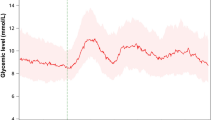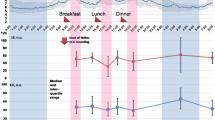Abstract
Circadian variations in the QT interval (QT) and QT dispersion are decreased in patients with type 2 diabetes because of cardioneuropathy. Insulin resistance has been recently identified as an independent determinant of QT prolongation in normoglycemic women. However, the relationship between QT prolongation and the degree of insulin resistance as well as circadian variation remains unclear in diabetic patients. This study was designed to assess the relationship between insulin resistance and the circadian variation in QT measurements in patients with type 2 diabetes. In 14 patients with diabetes, QT, corrected QT (QTc), QT dispersion, QTc dispersion, and RR interval (RR) were analyzed using 12-lead Holter monitoring and commercial software. The degree of diurnal variation in each measurement was defined as the amplitude between the maximum and mean values on curves fitted using the mean cosinor method (A_QT, A_QTc, A_QT dispersion, A_QTc dispersion, and A_RR). The cosine curve was fitted to all measured values in each QT measurement and RR for 24 h. Insulin resistance (glucose infusion rate (GIR)) was measured using the euglycemic hyperinsulinemic glucose clamp method. The maximum QT, QTc, QT dispersion, and QTc dispersion were >450 ms. GIR was significantly correlated with A_QT only (r = 0.59, P < 0.05). GIR was not correlated with other variables, and was dependent only on the circadian variation in QT.



Similar content being viewed by others
References
Molar J, Zhang F, Weiss J, Ehlert FA, Rosenthal JE (1996) Diurnal pattern of QTc interval: how long is prolonged? Possible relation to circadian triggers of cardiovascular events. J Am Coll Cardiol 27:76–83
Yi G, Guo XH, Reardon M, Reardon M, Gallagher MM, Hnatkova K, Camm AJ, Malik M (1998) Circadian variation of the QT interval in patients with sudden cardiac death after myocardial infarction. Am J Cardiol 81:950–956
Bellavere F, Ferri M, Guarini L, Bax G, Piccoli A, Cardone C, Fedele D (1988) Pronged QT period in diabetic autonomic neuropathy: a possible role in sudden cardiac death? Br Heart J 59:379–383
Ong JJC, Sarma JSM, Venkataraman K, Levin SR, Singh BN (1993) Circadian rhythm city of heart rate and QTc interval in diabetic autonomic neuropathy: implications for the mechanism of sudden death. Am Heart J 125:744–752
Browne KF, Prystowsky E, Heder JJ, Chilson D, Zipes D (1983) Prolongation of the Q-T interval in man during sleep. Am J Cardiol 52:55–59
Bexton R, Vallin H, Camm AJ (1986) Diurnal variation of the QT interval—influence of the autonomic nervous system. Br Heart J 55:253–258
Murakawa Y, Inoue H, Nozaki A, Sugimoto T (1992) Role of sympathovagal interaction in diurnal variation of QT interval. Am J Cardiol 63:339–343
Molnar J, Rosenthal JE, Weiss JS, Somberg JC (1997) QT interval dispersion in healthy subjects and survivors of sudden cardiac death: circadian variation in a twenty-four-hour assessment. Am J Cardiol 79:1190–1193
Shin HS, Lee WY, Kim SW, Jung CH, Rhee EJ, Kim BJ, Sung KC, Kim BS, Kang JH, Lee MH, Park JR (2005) Sex difference in the relationship between insulin resistance and corrected QT interval in non-diabetic subjects. Circ J 69:409–413
Fioentini A, Perciaccante A, Valente R, Paris A, Serra P, Tubani L (2010) The correlation among QTc interval, hyperglycemia and the impaired autonomic activity. Autonomic Neurosci 154:94–98
Schroedere E, Chambless L, Liao D, Prineas RJ, Evans G, Rosamond W, Heiss G (2005) Diabetes, glucose, insulin, and heart rate variability. Diabetes Care 28:668–674
Malik M, Batchvarov VS (2000) Measurement, interpretation and clinical potential of QT dispersion. J Am Coll Cardiol 36:1749–1766
Hansen S, Rasmussen V, Larsen K, Torp-Pedersen C, Jensen GB (2007) Circadian variation in QT dispersion determined from a 12-lead Holter recording: a methodological study of an age- and sex-stratified group of healthy subjects. Ann Noninvasive Electrocardiol 12:185–196
Sherrid MV, Cotiga D, Hart D, Ehlert F, Haas TS, Shen W, Link MS, Mark Estates NA, Epstein AE, Semsarian C, Daubert JP, Winters SL, Giudici MC, Maron BJ (2009) Relation of 12-lead electrocardiogram patterns to implanted defibrillator-terminated ventricular tachyarrhythmias in hypertrophic cardiomyopathy. Am J Cardiol 104:1722–1726
Priori SG, Mortara DW, Napolitano C, Diehl L, Paganini V, Cantu F, Cantu G, Schwartz P (1997) Evaluation of the spatial aspects of T-wave complexity in the long QT syndrome. Circulation 96:3006–3012
Hansen S, Rasmussen V, Torp-Pederson C, Jensen G (2008) QT interval and QT dispersion determined from a 12-lead 24-hour Holter recording in patients with coronary artery disease and patients with heart failure. Ann Noninvasive Electrocardiol 13:22–30
Leonardis V, Cinelli P, Capacci F, De Scalzi M, Citi S (1983) Circadian rhythm in dynamic electrocardiography. J Electrocardiol 16:351–354
Xue Q, Reddy S (1998) Algorithms for computerized QT analysis. J Electrocardiol 30:181–186
DeFronzo RA (1979) The glucose clamp technique: a method for quantifying insulin secretion and resistance. Am J Physiol 237:E214–E233
Ikeda N, Nakajima R, Utsunomia M, Hori M, Itaya H, Makino K, Ono T, Yamamoto M, Nemoto N, Iijima R, Hara H, Takagi T, Hara H, Nakamura M, Sugi K (2011) Higher body mass index at the time of acute myocardial infarction is associated with a favorable long-term prognosis (8-year follow-up). Heart Vessels 26:495–501
Ikeda N, Nakajima R, Tsunoda T, Nakamura M, Sugi K (2007) Insulin resistance and acute coronary syndrome in the young Japanese population have a strong association. Heart Vessels 22:165–169
Lazzeri C, Valente S, Chiostri M, Attana` P, Picariello C, Gensini GF (2012) Impact of hypertension on short- and long-term prognoses in patients with ST elevation myocardial infarction and without previously known diabetes. Heart Vessels 27:370–376
El-Gamal A, Gallagher D, Nawras A, Gandhi P, Gomez J, Allison D, Steinberg J, Shumacher D, Blank R, Heymsfield S (1995) Effect of obesity on QT, RR, and QTc intervals. Am J Cardiol 75:956–959
Lin YC, Huang J, Kan H, Castranova V, Frisbee JC, Yu HG (2011) Defective calcium inactivation causes long QT in obese insulin-resistant rat. Am J Physiol Heart Circ Physiol 302:H1013–H1022
Merri M, Moss AJ, Benhorin J, Locati E, Alberti M, Bandilini F (1992) Relation between ventricular repolarization duration and cardiac cycle length during 24-hour recording: findings in normal patients and patients with long QT syndrome. Circulation 85:1816–1821
Franz MR, Swerdlow CD, Liem LB, Schaefer J (1988) Cycle length dependence of human action potential duration in vivo. Effects of single extrastimuli, sudden sustained rate acceleration and deceleration, and different steady-state frequencies. J Clin Invest 82:972–979
Valensi PE, Extramania F, Johnson NB, Motte G, Maison-Blanche P, Coumel P (2002) Influence of cardiac autonomic neuropathy on heart rate dependence of ventricular repolarization in diabetic patients. Diabetic Care 25:918–923
Ewing DJ, Boland O, Neilson JM, Cho CG, Clarke BF (1991) Autonomic neuropathy, QT interval lengthening, and unexpected deaths in male diabetic patients. Diabetologia 34:182–185
Berger RD, Kasper EK, Baughman KL, Marban E, Calkins H, Tomaselli G (1997) Beat-to-beat QT interval variability: novel evidence for repolarization lability in ischemic and nonischemic dilated cardiomyopathy. Circulation 96:1557–1565
Haigney MC, Zareba W, Gentlesk PJ, Goldstein RE, Illovsky M, McNitt S, Andrew M, Moss AJ, the MADIT II investigators (2004) QT interval variability and spontaneous ventricular tachycardia or fibrillation in the multicenter autonomic defibrillator implantation trial (MADIT) II patients. J Am Coll Cardiol 44:1481–1487
Furukawa Y, Shimizu H, Hiromoto K, Kanemori T, Masuyama T, Ohyanagi M (2006) Circadian variation of beat-to-beat QT interval variability in patients with prior myocardial infarction and the effect of beta-blocker therapy. PACE 29:479–486
Day CP, McComb JM, Campbell RWF (1990) QT dispersion: an indication of arrhythmia risk in patients with long QT intervals. Br Heart J 63:342–344
Fogari R, Zoppi A, Maffioli P, Monti C, Lazzari P, Mugellini A, Derosa G (2012) Effects of aliskiren on QT duration and dispersion in hypertensive patients with type 2 diabetes mellitus. Diabetes Obes Metab 14:341–347
Acknowledgments
The authors would like to thank Enago (www.enago.jp) for the English language review.
Author information
Authors and Affiliations
Corresponding author
Rights and permissions
About this article
Cite this article
Tanaka, K., Yodogawa, K., Ono, T. et al. Greater insulin resistance indicates decreased diurnal variation in the QT interval in patients with type 2 diabetes. Heart Vessels 29, 256–262 (2014). https://doi.org/10.1007/s00380-013-0356-8
Received:
Accepted:
Published:
Issue Date:
DOI: https://doi.org/10.1007/s00380-013-0356-8




